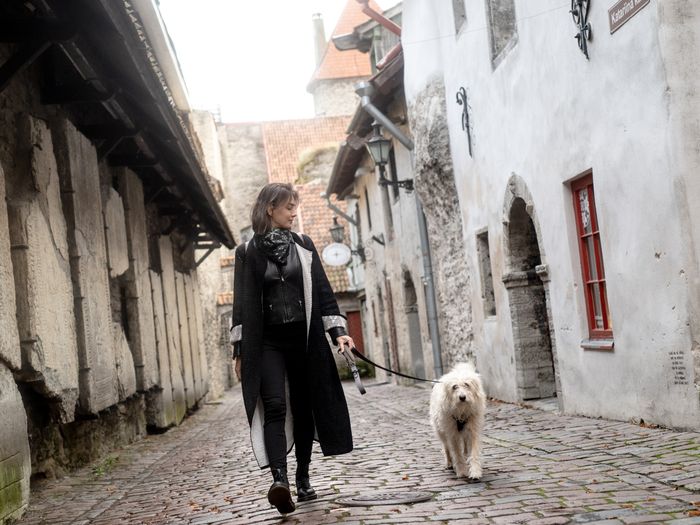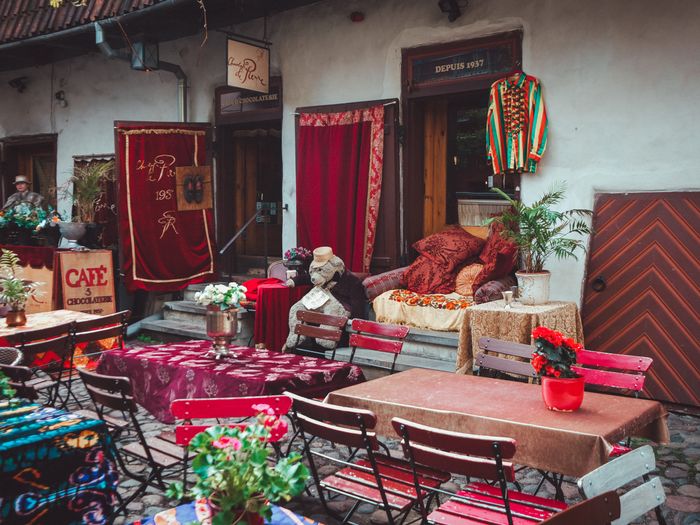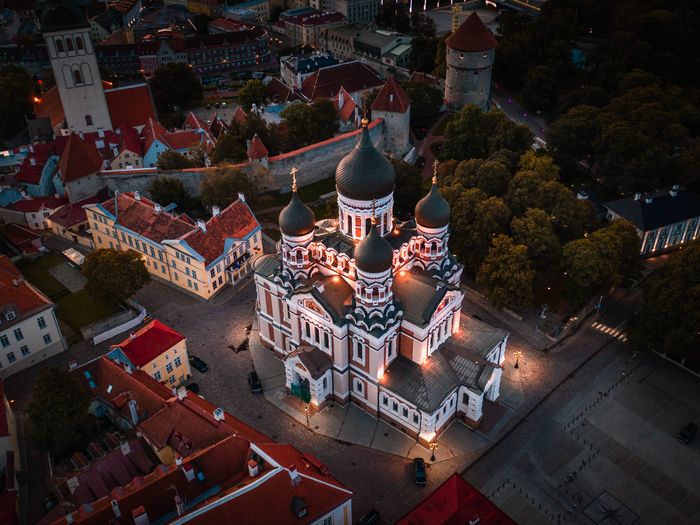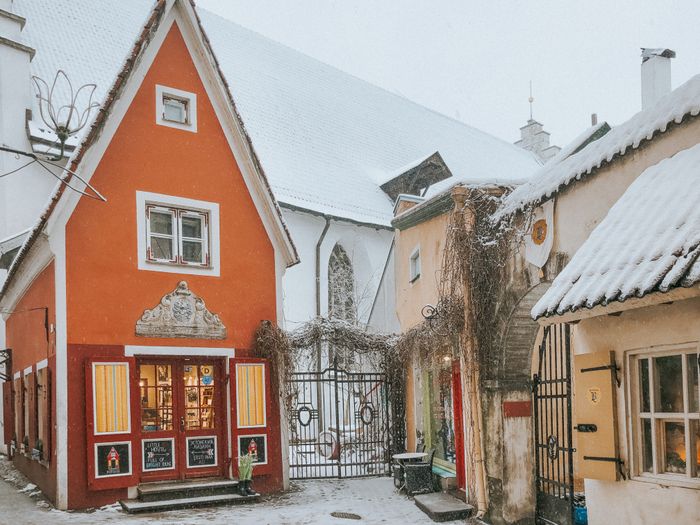
Epic streets in Tallinn
03.03.2021
Noora
Karppi
Tallinn has over 1600 streets. Three of the biggest ones are Narva, Tartu and Pärnu roads connecting the biggest cities in Estonia. Three of the oldest ones you can find in the Old Town. And which ones are the three prettiest streets? We'll let you decide.
For the most epic streets in town, we have created a list for you, introducing the most famous Tallinn streets from A to Y.
Most authentic medieval street – Aida
Aida street is hard to find in the Old Town, but once you get there, it is like you have jumped right back to the Middle Ages. The street is mostly untouched and offers a view of the city theater's summer stage. Apparently, it is also a popular place for wedding photoshoots.
Most cultural street – G. Otsa
Otsa street is named after Georg Ots, who was a famous Estonian baritone in the Soviet period. G. Otsa street connects Georg Otsa music school, the Estonian Drama Theater, Estonia National Opera House, and Alexela Concert Hallnext to the Solaris Centre.
Estonian media street – Gonsiori
Connecting the city centre and Kadriorg, Gonsiori is the address of the national broadcasting company ERR. Gonsiori is named after Jakob Johann Gonsior, alderman of the city council in the 19th century.
Wettest street – Jõe
Jõe means river in Estonian, and this street is actually built on a river. River Härjapea connected Ülemiste lake and Tallinn Bay. The Härjapea used to fill the city's moats in the Middle Ages: it was the water supply for the outskirts and source for industries, but later became polluted and was covered and diverted in the mid-1930s.
Prettiest street – Katariina käik
Katariina käik, St. Catherine’s Passage, is a hidden small alley in the Old Town. St. Catherine’s Passage connects Vene street and Müürivahe street. It is a picture-perfect street, with a lot of history.

Most educational street – Kooli
The pretty little street called Kooli, or school, starts in front of Gustav Adolf Grammar School, the oldest still-working school in Tallinn. The secondary school was established by the Swedish king Gustavus Adolphus in 1631.
Greenest street – Kloostrimetsa
Kloostrimetsa lane takes you through the pine forests in Pirita. Here you will also find the greenest sight in Tallinn, the Botanic Garden. You can also take a moment and explore Metsakalmistu, the Forest Cemetery, the resting place of Estonia’s luminaries.
Most geological street – Laagna
Locals refer to Laagna road as “Lasnamäe channel” as it runs through Lasnamäe district and cuts through limestone, exposing the layers of ground to people passing by. The original concept, according to Soviet architects, was to make the area more liveable by having traffic pass underneath pedestrians. Laagna street has never finished as planned; between the lanes grows grass where there should be tram tracks.
Street with most museums – Lai
The Museum of Puppetry Arts, the Estonian Health Museum, the Estonian Museum of Applied Art and Design, and the Estonian Museum of Natural History are all located on Lai (wide or broad) street in the Old Town. This is one of the oldest streets in Tallinn.
Most haunted street – Lühike Jalg
Lühike Jalg is a narrow street with lots of stairs that connect Toompea with lower Old Town. This is the place that has many ghosts wandering around. Watch out for the monk in Lühike Jalg, and listen to the footsteps and slamming doors in Maiden's Tower.
Cutest dead-end – Master’s courtyard
The street that leads to nowhere and everywhere at the same time, Master’s courtyard is a cute little cul-de-sac departing from Vene Street in the Old Town. Enjoy cakes and coffee à la française and chat with the local artisans who have small studios and shops at the courtyard.

Best street for an afternoon stroll – Müürivahe
Müürivahe is a lovely, narrow, but quite a long street inside the walls of the Old Town. It is a relaxing street to stroll down, sit down and enjoy a coffe cup on a sunny day.
Most religious street – Piiskopi
Tallinn has many churches, and Piiskopi Street connects two of the most powerful ones. Standing opposite Toompea Castle, the seat of power in Estonia, is St. Alexander Nevsky Cathedral, Estonia’s main Russian Orthodox cathedral. On the other end of Piiskopi stands the Cathedral of Saint Mary the Virgin, a.k.a. Dome Church.

Oldest street – Pikk
This street has existed for almost a millennium. It is the oldest and also one of the longest streets in the Old Town. During the Middle Ages, Pikk was the main street, along with Lai street, that led from Toompea to the sea.
Steepest street – Pikk Jalg
Pikk Jalg climbs up to Toompea from the lower Old Town. Pikk Jalg means long leg in Estonian, the parallel street, Lühike Jalg means short leg. This is why sometimes Tallinn is called the town that limps.
Sunniest street – Pirita
Pirita road has existed, in some form, since St. Bridget's Convent was founded in the 13th century. The road runs by Tallinn Bay, with magnificent views to the sea and Old Town. Between the sea and the road is the local favourite, Pirita promenade, a perfect place to enjoy a sunny day.
Narrowest street – Rahukohtu
Rahukohtu street can be found in Toompea. It connects Dome Church and Stenbock House, the office of the Prime Minister. After Stenbock House, just before Patkuli viewing platform, Rahukohtu street takes a steep turn to the right and gets quite narrow - So narrow that in an earlier time, ladies with fashionable wide dresses could not pass one another on the street!
Street with most street food vendors – Reisijate
Reisijate street connects Balti Jaam Market, and its street food vendors, with Depoo street food court. Enjoy delicious street food from all the corners of the world, all year round.
Street with the darkest history – Roosikrantsi
Roosikrantsi has previously been called Barbara street, as there used to be St. Barbara’s chapel and cemetery just outside the town wall where the street begins. During the Middle Ages, people who had died of famine or the Plague were buried here. The name Roosikrantsi may come from the execution place that used to be close by, called Rosenkranz. There were monks saying prayers for criminals who were going to be executed to save their souls. The alternative story is that the name could be, because a man called Michel Rosenkrans bought some land by the street in the 15th century.
Sweetest street – Saiakang
White bread passage, or Saiakang in Estonian, is the small street between Town Hall Square and Pühavaimu street. The name originates from 13th century when there were at least eight small bakeries and shops selling local croissants. Today you can find two cafés at Saiakang.

Most mysterious street – Stalkeri käik
Stalkeri käik, Stalker’s Path, is named after the cult Soviet film. Andrei Tarkovsky movie “Stalker” was shot here in the 70s. The path still has that stalker vibe. Stalker’s path is located in the trendy Rotermann Quarter. The area has many shops, restaurants and cafés.
Most colourful street – Valgevase
Kalamaja is known for its wooden architecture. Valgevase street runs through Kalamaja, and is filled with colourful wooden houses. Valgevase means brass in Estonian. The street got its name from a local foundry.
Tastiest street – Vene
In the centre of the Old Town, on Vene street, are many restaurants offering tasty delicacies from different national cuisines. Try Italian, Indian or Russian cuisine, or anything in between.
Shopping street – Viru
Shop ‘til you drop. Everything from flowers to shoes and souvenirs can be found on Viru street.
Newest old street - Nõelasilm
Nõelasilm means the eye of the needle. It is truly an eye of the needle; it’s quite hard to find the narrow passageway taking you from Rüütli street to the Danish King’s Garden. It was re-built and re-opened in 2007.


